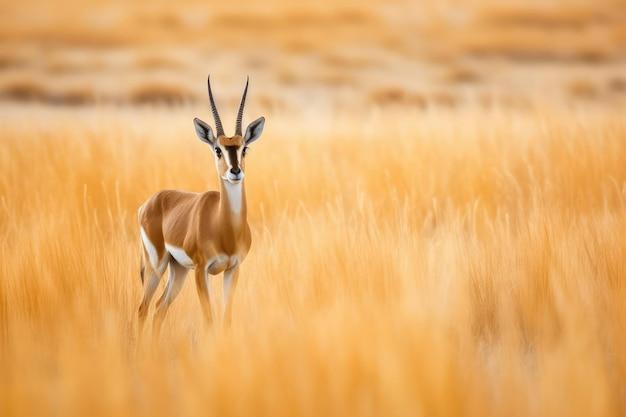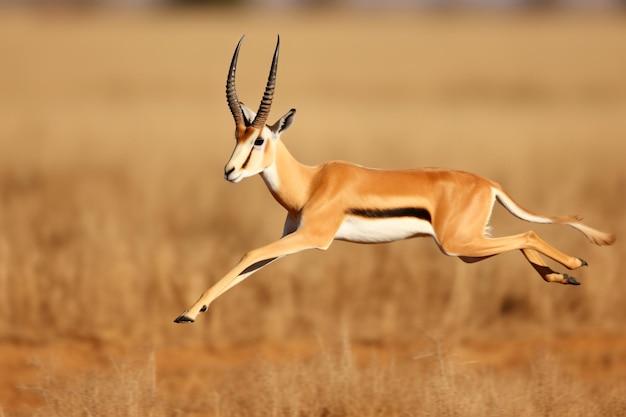The desert is a harsh and unforgiving environment, characterized by scorching temperatures, limited water resources, and vast stretches of barren sand. Surviving in such extreme conditions requires remarkable adaptations, and one animal that has mastered the art of desert survival is the gazelle. Known for its elegance and agility, the gazelle has evolved a range of fascinating strategies to thrive in the arid wilderness.
In this blog post, we will delve into the remarkable ways the gazelle manages to endure the desert’s challenges. From its exceptional jumping ability to the unique phenomenon of organ shrinking during extreme heat, we will explore the fascinating insights into how the gazelle copes with the harsh climate. Additionally, we will touch upon the gazelle’s behavior and the broader techniques employed by desert animals to conserve water in their arid surroundings.
So, join us on this journey as we uncover the secrets of the gazelle’s survival in the desert and gain a deeper appreciation for the astonishing adaptations that enable this magnificent creature to thrive.

How the Gazelle Thrives in the Desert
The arid and harsh environment of the desert may seem like an unforgiving place for most animals, but not for the resilient gazelle. These magnificent creatures have developed unique strategies to not only survive but thrive in the desert. Let’s take a closer look at how the gazelle manages to conquer these challenging conditions.
Adaptation is the Name of the Game
Camouflage:
The first rule of survival in the desert is to blend in, and the gazelle knows this all too well. With its sandy-colored coat, the gazelle effortlessly merges with the surroundings, making it difficult for predators to spot them in the vast expanse of the desert.
Water-Wise:
In a land where water is scarce, the gazelle has become a master of conservation. They can go for long periods without drinking water by extracting moisture from the plants they consume. This incredible ability allows them to survive even in the driest of conditions.
Gazelle’s Superpowers
Speed Demon:
Have you ever tried to catch a gazelle? Don’t bother—it’s impossible! These nimble-footed creatures can reach speeds of up to 60 miles per hour in a matter of seconds. Their powerful legs and lightweight bodies are designed for swift escapes, ensuring they outpace any potential threat. It’s like trying to catch the wind—spoiler alert, you can’t!
Built-in Air Conditioning:
On scorching hot days, we’re all grateful for air conditioning. Well, guess what? Gazelles have their own built-in cooling system. Their large ears increase their surface area, allowing heat to dissipate more quickly and helping them to stay cool in the blazing desert heat. If only we humans had such handy features!
Hotfoot Houdini:
Not only are gazelles fast, but they’re also remarkably agile. Dodging and weaving through the treacherous desert terrain is a walk in the park for these acrobatic marvels. Their hooves are specially adapted with a soft cushion that not only enhances their grip but also reduces the impact on their delicate joints. It’s like wearing the perfect pair of sneakers—every step is a breeze!
Gazelle’s Survival Techniques
Safety in Numbers:
Gazelles are social creatures that prefer to roam in herds. By sticking together, they create a united front against predators. Additionally, the more eyes there are to watch for danger, the better their chances of avoiding an unwanted encounter. It’s like having your own personal bodyguard squad in the desert!
Under the Radar:
When the desert sun is at its peak, the gazelle knows how to stay low and avoid unnecessary attention. By adopting a crouched position, they minimize their visibility and exposure to potential threats. It’s like they’ve enrolled in Gazelle Ninja School and mastered the art of stealth!
Early Bird Catches the Grass:
In the desert, where food is scarce, the gazelle has learned to make the most of mealtimes. They are most active during the cooler hours of the day, like dawn and dusk, when the plants are still moist from the night’s dew. By being early risers, they secure their share of the limited resources. It’s like they’ve got a gourmet reservation at the desert’s finest restaurant!
Nature’s Desert Marvel
The gazelle’s ability to not only survive but thrive in the desert is a feat worth admiring. From blending in seamlessly to using clever adaptations and employing smart survival techniques, these graceful creatures prove time and again that they are the true masters of their arid domain. So the next time you find yourself in the desert, keep an eye out for these incredible animals and marvel at their desert prowess—just be prepared to be amazed!

FAQ: How does the Gazelle Survive in the Desert?
The majestic gazelle is a fascinating creature known for its ability to thrive in one of the harshest environments on Earth—the desert. From their unique physiological adaptations to their clever survival strategies, gazelles have managed to conquer the scorching sands with poise and grace. Curious to know more about these incredible desert dwellers? We’ve got you covered with some frequently asked questions about how the gazelle survives in the desert.
How Does the Gazelle Survive in the Desert
The gazelle has evolved a set of remarkable adaptations that allow it to cope with the challenging desert conditions. These adaptations include:
Speed and Agility: The gazelle is built for speed, with long, slender legs and lightweight bodies. This enables them to outrun their predators, such as cheetahs and lions. Their agility further helps them navigate the uneven desert terrain with ease.
Efficient Water Conservation: Gazelles have adapted to conserve water in their bodies, allowing them to withstand long periods without drinking. They have highly efficient kidneys that enable them to reabsorb water from their urine, reducing water loss. Additionally, their nostrils can close tightly in order to minimize water loss through respiration.
Cooling Mechanisms: To combat the extreme heat of the desert, gazelles have a unique cooling system. They can pant, similar to dogs, to increase the airflow over their moist nasal passages, facilitating evaporative cooling. This helps regulate their body temperature and prevent overheating.
How High Can a Gazelle Jump
When it comes to leaping to great heights, gazelles are true acrobats of the desert! With their powerful hind legs and incredible strength, they can jump up to 10 feet in the air. This not only allows them to easily leap over obstacles and evade predators but also helps them reach vegetation that would otherwise be out of reach.
Why Do Sand Gazelles Shrink Their Organs During Extreme Hot Climates and Why the Heart and Liver of All Organs
Sand gazelles have a fascinating adaptation to cope with the extreme heat of the desert. During periods of extreme temperature, they can shrink certain organs, particularly the heart and liver. This unique ability helps them conserve water by reducing the metabolic demands of these organs. By minimizing the size of their heart and liver, gazelles can limit their water loss and increase their chances of survival in the desert.
What Does a Gazelle Do
Gazelles are constantly on the move, searching for food and water in the vast expanse of the desert. They are herbivores, feeding on a variety of desert vegetation such as grasses, leaves, and shrubs. Their keen eyesight and acute hearing allow them to detect predators from a distance, enabling them to escape potential threats with their incredible speed and agility.
How Do Desert Animals Conserve Water
Desert animals, including gazelles, have developed a range of strategies to conserve water in their arid habitats. These strategies include:
Nocturnal Habits: Many desert animals, including gazelles, have adapted to be active during the cooler nighttime hours. By avoiding the scorching heat of the sun, they can reduce the amount of water lost through sweating and panting.
Efficient Urine Concentration: Desert animals have highly efficient kidneys that can concentrate their urine, minimizing water loss. This allows them to extract as much water as possible from their food and excrete highly concentrated waste.
Minimal Sweating and Panting: Sweating and panting are natural mechanisms to cool down, but in the desert, every drop of water counts. Desert animals like gazelles have evolved to minimize sweating and panting, reducing water loss through evaporation.
Specialized Diets: Desert animals often have specialized diets that provide them with moisture. For example, gazelles obtain a significant portion of their water requirement from the plants they consume.
Remember, the next time you encounter a gazelle gracefully bounding across the desert sands, marvel at the incredible adaptations and survival strategies that allow it to thrive in such a challenging environment. These desert dwellers truly exemplify the remarkable abilities of nature’s engineering.
